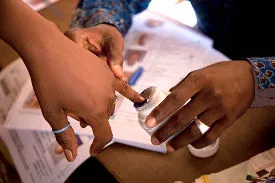Electoral Risk Management: A new standard for organizing elections

While risk management has been an integral part in the business sector for decades the practice remains rare when it comes to electoral management bodies (EMBs).
In a recent survey commissioned by International IDEA only 18 out of 89 countries said they had formal electoral risk management procedures in place while 35 countries reported not having any electoral risk management procedures at all.
The remaining 36 had informal risk management practices such as regular stakeholder meetings, information and communications technology related procedures and trainings.
This suggests that while only a minority of countries have implemented electoral risk management into the electoral process the interest in doing so is increasing as EMBs become more aware of the needs, possibilities and benefits to monitoring and managing risks.
The Electoral Risk Management Conference, hosted by International IDEA and the African Union Commission, on 1-3 December, picked up on this trend and participants could learn about the different kinds of risks that can occur in the electoral process and how to limit or eliminate these risks.
Speaking at the conference, Sead Alihodzic, International IDEA Senior Programme Officer, said the risks can first broadly be divided into two categories; internal and external risks.
“Internal risks are all the problems and issues EMBs face in planning and implementing their operations, while external risks are in the context in which the elections take place.”
Internal risks include malfunctioning voting machines, difficulties in voter registration while external often centre on violence and intimidations that can take place during and around elections. But monitoring and managing these risks should be done throughout the electoral process and not just in close connection to election day. Tools such as International IDEA’s Electoral Risk Management Tool (ERMTool) benefit from being used over time and over several elections.
The tool has been used successfully in elections in several African countries, including Nigeria and Kenya, Olabisi Dare, Head of Division for Humanitarian Affairs, Department of Political Affairs, said during the opening session.
“The AU has embraced the use of the ERMTool in Africa is because of the many examples where elections have turned violent or been discredited and because the AU has seen the benefits. We have seen the success of the tool in Kenya, Nigeria and other countries.
In addition to differentiating internal and external electoral risks, within these, one can distinguish between legal, political, technical and operational risks. Some of these risks are difficult to avoid but, Alihodzic said, but there is a difference between “hitting the wall without knowing it and knowing that you are about to hit the wall”.
“If you know you are about to you can limit the impact.”
If a country has successfully implemented risk management into the electoral process you can often predict problems and work to minimize or eliminate them before they grow out of control.
In his keynote address, S.Y. Quraishi, former chair of the Election Commission of India and International IDEA Board of Adviser member, gave specific examples of challenges when setting up elections in the world’s largest democracy.
“You must think that everything that can go wrong will go wrong … you must prepare meticulously,” he said. “Every election should be better than the last you must learn from each election.”
The Indian Election Commission has implemented electoral risk management in all their work and there are many risks to consider. Quraishi jokingly referred to Murphy’s Law saying that when it comes to elections “if anything can go wrong it will”.
“At the most inopportune moment. Therefore it is important to always have a plan B, C and D.”
But, he added, today the good elections no longer make the news in India. It is the norm, made possible by an effective electoral risk management system.
Others who shared their experiences of electoral risk management during the conference included Kevin Kitson, Australian Electoral Commission, Irena Hadziabdic, of the Central Election Commission of Bosnia Herzegovina and Faraj Mohamed Zaid, at the High National Elections Commissions of Libya, which recently started using the ERMTool.
Zaid spoke about the security situation in Libya and how it is influencing the conduct of the electoral process. The fragile security situation there has hindered any efforts to continue the transitional phase.



